Oct. 17, 2025
In plumbing systems, plumbing fittings are essential components that help to connect different pipes and control the flow of water or gas. Understanding the different types of plumbing fittings and their uses is crucial when designing or maintaining a plumbing system, whether in residential or commercial buildings.
In this guide, we will explain the most common types of plumbing fittings, their applications, and how to choose the right one for your project.
ASK FOR Types of Pipe Fittings PRICE
The role of pipe fittings in a plumbing system is to connect multiple pipes of the same size or different sizes to change direction, change size, and branch connections. Different pipe fittings play different roles according to shape or process requirements. They are made of different materials, common ones are copper, iron, brass, PVC, etc. There are many types of fittings used in plumbing systems, depending on their purpose and function.
Elbows are used to change the direction of pipes. According to the angle, there are usually 45 degrees and 90 degrees; there are also bends and U-shaped return bend. If two pipes of the same diameter are connected, an equal elbow can be used, otherwise, a reducing elbow can be used. Elbow fittings are generally threaded, with internal threads, or internal and external threads. There are also grooved pipe fittings without threads, which generally have 11.25 degrees, 22.5 degrees, 45 degrees, and 90 degrees, and can be connected by groove couplings. Carbon steel elbow fittings can be connected by welding.
Application: Can be used to connect straight pipes, pipes and equipment, or pipes and pipes.
Function: The elbow is used to change the flow direction of the pipe. It is usually bent at an angle of 90 degrees or 45 degrees.
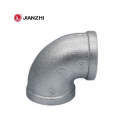 |  | 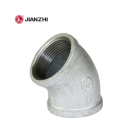 | 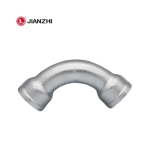 | 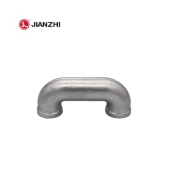 |
| 90 degree elbow | 90 degree elbow, reducing | 45 degree elbow | Bend 90 degree, female | return bend |
ASK FOR Types of Pipe Fittings PRICE
The tee fitting is T-shaped with three outlets. The two pipes connected by it are perpendicular at 90 degrees. It can make a pipeline branch flow out from two outlets, or it can combine two inlet branch flows into one. According to the diameter of its three ports, it is divided into the equal tee and reducing tee.
Application: Can be used to divert, merge, or distribute fluids.
Function: Tee fittings have one inlet and two outlets and are often used to divide pipes into two directions or to merge two pipes into one.
 | 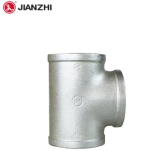 | 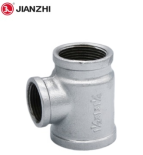 | 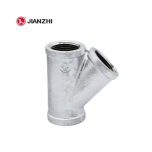 |
| Equal tee | reducing tee | grooved reducing tee | Lateral Y Branch, 45° |
ASK FOR Types of Pipe Fittings PRICE
A cross is a pipe fitting with four openings, connecting four pipes at right angles in twos. Because it is in the center of the four connection points, it experiences more stress. From this point of view, the raw materials of cross need to be of high quality, and the processing process needs to be very strict. Cross are commonly used in firefighting systems.
Application: Usually used to divide pipelines into two or three directions or to merge multiple pipelines.
Function: Similar to a tee, but a cross-fitting has one inlet and three outlets.
 | 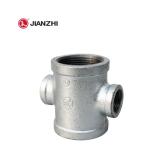 |
Cross, equal | Cross, reducing |
ASK FOR Types of Pipe Fittings PRICE
Coupling is a common pipe fitting that connects two pipes, and there are several types of equal, reducing and F&M. Precision threads ensure it won't leak. Couplings made of plastic are provided with gaskets or rubber seals on both sides to prevent leakage.
Application: Used to connect two sections of pipeline to form a continuous pipeline line.
Function: It is usually used to connect adjacent pipeline segments to ensure the integrity and sealing of the pipeline system.
 |  | 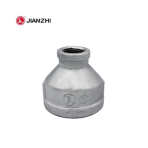 | 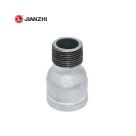 | 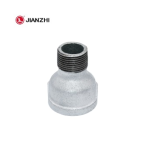 |
| Socket, entire threaded | Socket, part threaded | Socket, reducing | Socket, M&F | Socket, M&F,reducing |
ASK FOR Types of Pipe Fittings PRICE
The function of the union is similar to the coupling, the difference is that the union is composed of three parts: the nut, the external thread and the internal thread. When needed, the central nut can be turned to remove the fitting without disturbing the rest of the pipe.
Application: Union is usually used to connect different parts of the pipeline system, such as pipes and pipes, pipes and valves, pipes and equipment, etc., to achieve the continuity and integrity of the pipeline system.
Function: Convenient when pipe maintenance, repair or pipe component replacement is required without having to dismantle the entire pipe line.
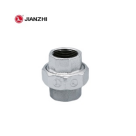 |  |  |
| Union, flat seat | Union, flat seat, M& | Union, conical seat,M&F |
ASK FOR Types of Pipe Fittings PRICE
The nipple is externally threaded and is used to connect two pipes. The length of the Nipple is determined by the length of the thread. The center of the Nipple has a hexagonal cross-section to facilitate the wrench to turn it.
Application: The nipple is usually used to connect two sections of the pipeline to make the pipeline system continuous. It can connect pipes of the same material or pipes of different materials.
Function: In some specific applications, the height or position of the pipe needs to be adjusted, and it can also be used as a connector to connect the pipe and accessories so that the accessories can be installed in the pipeline system.
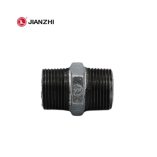 | 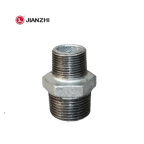 |
| Nipple, equal | Nipple, reducing |
ASK FOR Types of Pipe Fittings PRICE
They are often used to temporarily restrict the flow of the plumbing system, which is necessary during inspection and repair work on piping systems.The plug is externally threaded and the cap is internally threaded.
Application: Usually used to seal the ends of pipes or other pipe openings that do not require connection.
Function: Effectively prevent liquid or gas leakage in pipelines, ensure that pipeline ports are completely sealed, and prevent external impurities from entering the pipeline system.
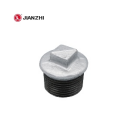 |  | 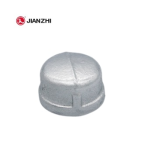 | 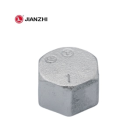 |
| Plug, beaded | Plug, plain | Cap, roun | Cap, hexagon |
ASK FOR Types of Pipe Fittings PRICE
Choosing the right fitting depends on factors like the type of plumbing system, the materials being used, and the function of the pipe. Ensure that the fitting is compatible with the pipe material (e.g., copper, PVC, steel) and meets local plumbing codes.
In Brazil, the plumbing industry often uses materials like PVC, CPVC, and copper for various fittings. The PVC fittings are widely used in residential and commercial projects because they are affordable and durable.
Plumbing fittings commonly used in Brazil include:
☑ PVC elbows and tees for residential plumbing systems.
☑ Metal fittings for commercial systems that require high strength and heat resistance.
☑ When working in Brazil, ensure that the plumbing system meets local standards and regulations.
Q1: What are the most common types of plumbing fittings?
A1: The most common plumbing fittings include elbows, tees, couplings, reducers, and adapters.
Q2: What is the difference between a coupling and an elbow fitting?
A2: A coupling joins two pipes together, while an elbow changes the direction of the pipe.
Q3: How do I choose the right plumbing fitting?
A3: The right fitting depends on the pipe material and the specific function within the plumbing system.
For over 40 years, the JIANZHI Group has been a cornerstone of the global malleable iron pipe fitting supply. We understand that your projects require more than just a product; they require a guarantee of performance.
We go beyond basic standards to deliver unparalleled durability:
◆ Superior Material Strength: Our fittings are manufactured from premium-grade malleable iron, achieving a 10% higher tensile strength than the Chinese National Standard (GB/T). This means superior resistance to cracking and deformation under high pressure.
◆ Enhanced Flexibility & Impact Resistance: With an extension rate 33% higher than the GB/T standard, our fittings offer greater ductility. This crucial property allows them to absorb shock and vibration without failing, a key advantage in dynamic systems and seismic zones.
We provide the robust, reliable foundation your plumbing systems need to last, helping you avoid the common pitfalls of the industry and protect your bottom line.
Ready to specify fittings that won't let you down? Contact Us Today or Explore Our Product Catalog to discover how four decades of manufacturing excellence can benefit your next project in Brazil and beyond.
You can click the link below to enter the youtube channel of Jianzhi Group to see how big the factory of Jianzhi Group is. Of course, you are welcome to inquire with us.
SAFER
PRODUCT INFO
ABOUT JIANZHI
TECH DATA
Contact Us
E-mail: sales1@jianzhi-fitting.com
Tel: +86 18698027872
Office In Tianjin:
Heping District, Tianjin, China.
Production Base 1:
Chifeng, Inner Mongolia, China.
Production Base 2:
Tangshan City, Hebei Province, China.
Production Base 3:
Schelei Street,Baicoi City,Prahova County,Romania
Service email: info.ro@jianzhi-fitting.com
Sales email: market.ro@jianzhi-fitting.com
Tel: +40(755)011 849
